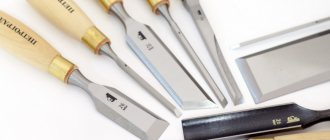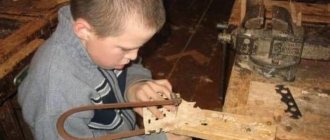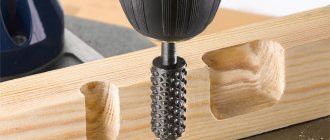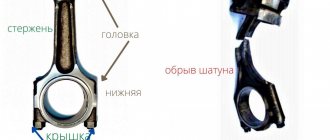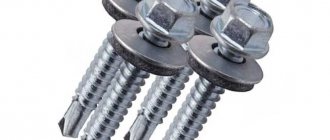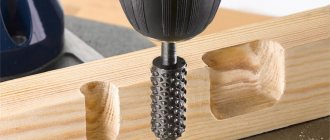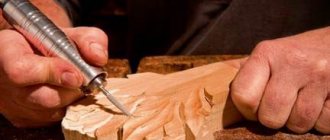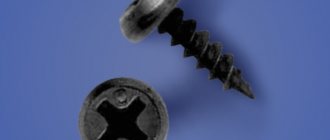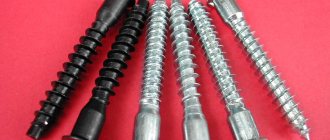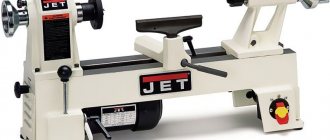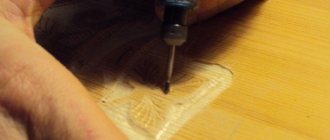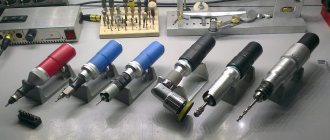Today in this article we will look at such an important topic as the correct choice of self-tapping screws. The fact is that, having communicated with consultants at various construction stores, we came to the conclusion that people often choose hardware (metal products, from the phrase) completely incorrectly, giving their choice to those self-tapping screws that cost the least. People often pay attention exclusively to length, which is fundamentally wrong.
If you have encountered the problem that when screwing or unscrewing hardware, they broke, then this was either due to low-quality screws or due to an incorrect choice.
In order to understand this seemingly complex topic at first glance, read our article further.
How to choose the right screws
So, in order to choose the right self-tapping screws, of which there are simply countless quantities sold today, you must first pay attention to the course of the thread.
- The thread stroke of self-tapping screws can be either frequent or rare.
- The frequent stroke of self-tapping screws is designed to screw them into metal surfaces.
- The rare stroke of self-tapping screws is designed to be screwed into soft surfaces such as plastic, plaster, and wood.
- Universal screws are those that can be screwed anywhere. If you don’t know what to buy, then buy universal screws.
- There are also special screws that are designed for specific tasks. A classic example is hardware with a faceted head, which is needed for installing roofing materials.
Differences between self-tapping screws and self-tapping screws
GOST 27017-86 defines a screw as a fastener in the form of a rod with an external special thread, a threaded conical end and a head at the other end, forming a thread in the hole of the wooden or plastic product being connected. From this definition it becomes clear that a screw is screwed into a previously prepared hole and is used for fastening to wooden or plastic bases. Such screws, usually made from low-carbon steels (St1, St2, St3, 10kp), less often from corrosion-resistant steels without coating and from brass, have traditionally been produced and are still produced by the domestic hardware industry.
However, fasteners have long appeared on the Russian market that, by formal definition, correspond to the term “screw”, but have significant differences:
- their main structural elements have been fundamentally improved: heads, threads on the rod, ends and splines;
- High-quality steels and alloys with modern protective and decorative coatings were used.
As a result, the functionality of these products has significantly expanded:
- it has become possible to install them without pre-drilling holes, which significantly simplifies and speeds up the installation process of the fastened products;
- The range of materials in which these products can be installed has expanded: steel, aluminum and copper alloys, composite materials, concrete, and brick have been added to wood and plastic.
Such significant differences between new products and screws required the emergence of a special term. And such products began to be called self-tapping screws, in short - self-tapping screws.
The main structural elements of screws or self-tapping screws are:
- head - part of a fastener that has a rod, serving to transmit torque and form a supporting surface;
- slot - a specially shaped recess at the end of the head, which serves to transmit torque from the tool;
- threaded rod;
- end.
What types of self-tapping screws are there?
| Type of thread | Appearance of the self-tapping screw | Scope of application |
| Rare pitch (large carving) | They are used when working with wood, as well as for fastening parts made of MDF, particle boards, plasterboard and fiberboards. | |
| Frequent pitch (fine thread) | Designed for fastening elements made of hard wood, as well as for metal structures (frames). | |
| Double thread (variable thread) | Used for fastening materials with different densities (for example, for fastening drywall to a wooden base) |
Three-dimensional slats
The modern Italian company produces fastening elements that are placed perpendicularly and vertically at an angle, using T-type slats created by extrusion from a high-strength steel alloy. They are produced in several modifications designed for different levels of loads.
The fastening system must be selected according to the size range of sections of the combined beams and the dynamic as well as static loads acting on them.
During the installation process, the slatted base is attached to the beam using self-tapping screws. Then a groove of the same size as the slatted shelf is created on the end part, attached to the base of the joist beam. If there is no perforation, the shelf is equipped with a log and the connection is secured using self-tapping screws.
Diameters and lengths of self-tapping screws with a countersunk head GOST 1145-80 and a semi-countersunk head GOST 1146-80
| Self-tapping screw diameter, mm | Self-tapping lengths, mm | Self-tapping screw diameter, mm | Self-tapping lengths, mm |
| 1,6 | 7, 10, 13 | 4,0 | 13, 16, (18), 20, (22), 25, 30, 35, 40, 45, 50, 60 |
| 2,0 | 7, 10, 13, 16 | 5,0 | 13, 16, (18), 20, (22), 25, 30, 35, 40, 45, 50, 60, 70 |
| 2,5 | 7, 10, 13, 16, (18), 20, (22), 25, | 6,0 | (18), 20, (22), 25, 30, 35, 40, 45, 50, 60, 70, 80, 90, 100 |
| 3,0 | 10, 13, 16, (18), 20, (22), 25, 30 | 8,0 | 50, 60, 70, 80, 90, 100 |
| 3,5 | 10, 13, 16, (18), 20, (22), 25, 30, 35, 40 | 10,0 | 80, 90, 100 |
Installation of tongue and groove flooring
This type of flooring is ideal for rooms with low ceilings. In this case, the board is installed directly on the floor, which has previously been leveled, covered with a waterproofing compound and a layer of plywood. Self-tapping screws should also be used to secure the base.
If it is planned to install it on an existing wooden floor, the board should be installed in the opposite direction in relation to the existing floor. You should first check the ability of the board to withstand additional loads, and only then install it and attach it to the base.
Lengths and diameters of self-tapping screws with a semicircular head according to GOST 1144-80
| Self-tapping screw diameter, mm | Rod lengths in mm | Self-tapping screw diameter, mm | Rod lengths in mm |
| 1,6 | 7, 10, 13 | 4,0 | 13, 16, (18), 20, (22), 25, 30, 35, 40, 45, 50, 60 |
| 2,0 | 7, 10, 13, 16 | 5,0 | 13, 16, (18), 20, (22), 25, 30, 35, 40, 45, 50, 60, 70 |
| 2,5 | 7, 10, 13, 16, (18), 20, (22), 25 | 6,0 | (18), 20, (22), 25, 30, 35, 40, 45, 50, 60, 70, 80, 90, 100 |
| 3,0 | 10, 13, 16, (18), 20, (22), 25, 30 | 8,0 | 50, 60, 70, 80, 90, 100 |
| 3,5 | 10, 13, 16, (18), 20, (22), 25, 30, 35, 40 | 10,0 | 80, 90, 100 |
Installing the floor on joists
Laying the boards on pre-prepared joists is a preferable option for rooms with significant space from the floor to the ceiling. The floor is installed using this technology in two stages.
Preparing the base. For these purposes, you should prepare a planed block with a width of 50 mm or more. The workpiece must be treated with protective compounds; applying an antiseptic to it will prevent the formation of mold in the future. The laying of lags must be preceded by a stage such as arranging a waterproofing layer with any available composition.
Taking into account the thickness of the board that will be used for laying the flooring, the distance between the beams is calculated. The thinner the board, the closer to each other the logs should be placed. In particular, the width of a larch board is 25 mm, which means you need to maintain a distance of 60 cm or less, but a wider pine board (36-41 mm) is laid on blanks located at a distance of about 1 meter from each other.
The bars must be laid in a direction perpendicular to the position of the board.
Laying the boards. It should be installed in the direction away from the wall. It is important to maintain a distance of 1-1.5 cm, which will be required in the future to evenly distribute the load. The first board should be screwed to the joists using self-tapping screws in those areas that will later be hidden by the baseboard.
Which screws to choose for a certain load
In order to choose the right hardware depending on the load, you can contact your sales consultant and ask him to help you. Or, you can look at our table and decide on your choice before going to the store.
Different screws depending on the load are presented in the table below.
| Load, kg | Standard size of the self-tapping screw depending on the wall material, excluding the thickness of the product being fixed | |||||
| Regular brick | Concrete | Tile | Porous concrete | Tree | Drywall | |
| less than 1.0 | 3×25 | 3×16 | 3×16 | 3×16 | 3×25 | 3×16 |
| up to 5.0 | 3×25 | 3×20 | 3×25 | 3×25 | 3×30 | 3×16* |
| up to 10.0 | 4×25 | 4×20 | 4×25 | 4×30 | 3×25 | 3×16* |
| up to 20.0 | 4×50 | 4×40 | 4×50 | 4×70 | 4×50 | 4×16* |
| up to 30.0 | 5×70 | 5×50 | 5×70 | 5×70 | 5×50 | 4×16* |
| up to 50.0 | 6×80 | 6×60 | 6×80 | 6×90 | 6×60 | – |
| up to 75.0 | 8×100 | 8×80 | 8×100 | 8×140 | 8×100 | – |
| up to 100.0 | 10×140 | 10×100 | 10×160 | 10×160 | 10×120 | – |
Encyclopedia of fastening standards
Taiwan Metiz Alliance
Encyclopedia of fastening standards
Self- tapping screws are self-tapping screws with a special external thread and a pointed end or drill-shaped tip that allows the screw to be driven into hard wood, plastic and metal sheets without first drilling a hole. Self-tapping screws come with rare threads for wood, plastic and with frequent threads for metal. Shapes of screw heads: flat, convex, semicircular, countersunk, semi-countersunk, cylindrical, hexagonal, countersinking, loop-shaped, half-loop. Types of head splines: straight, cruciform (Ph or Pz), internal hexagon, Torx. Roofing screws are available painted (up to 18 colors) with a hex head, washer and rubber gasket.
SCREWS
Comparison table of DIN, GOST and ISO
| Image | DIN name and dimensions | DIN | GOST | ISO |
| Self-tapping screw with a half round head with a shoulder and a cross-shaped slot for sheet metal | DIN 968 | |||
| Self-tapping screws with captive flat washers (combined) | DIN 6901 | |||
| Self-tapping screw, thread extrusion Taptite, cylindrical head with sphere, cross slot Pz | DIN 7500 C | |||
| Self-tapping screw, thread extrusion Taptite, hexagonal head with flange | DIN 7500 D | |||
| Self-tapping screw, thread extrusion Taptite, countersunk head slot Pz | DIN 7500 M | |||
| Screw self-tapping screw with hexagonal head with flange | DIN 7504 K | |||
| Self-tapping screw with long drill, hex head with flange | DIN 7504 K | |||
| Screw self-tapping screw with a semicircular reduced head | DIN 7504 M (N) | |||
| Self-tapping screw with countersunk head | DIN 7504P | |||
| Self-tapping screw with hex head, diameter from 3 to 8, length from 8 to 50 | DIN 7513 A | |||
| Self-tapping screw with cylindrical head, diameter from 2.5 to 8, length from 6 to 50 | DIN 7513 B | |||
| Self-tapping screw with countersunk head, diameter from 2.5 to 8, length from 6 to 50 | DIN 7513 F | |||
| Self-tapping screw with a semi-countersunk head, diameter from 2.5 to 8, length from 6 to 50 | DIN 7513G | |||
| Phillips self-tapping screw Ph, form A - lens-shaped head, form D - countersunk head, form E - semi-countersunk head. | DIN 7516 A DIN 7516 D DIN 7516 E | GOST 10621-80 | ||
| Self-tapping screw, self-tapping screw for wood with a cylindrical head with a slot and full thread, diameter from 2.2 to 8, length from 6.5 to 70 | DIN 7971 | ISO 1481 | ||
| Self-tapping screw, self-tapping screw for wood with a countersunk head with a slot and full thread, diameter from 2.2 to 6.3, length from 6.5 to 70 | DIN 7972 | ISO 1482 | ||
| Self-tapping screw, self-tapping screw for wood with a semi-countersunk head with a slot and full thread, diameter from 2.2 to 6.3, length from 6.5 to 70 | DIN 7973 | ISO 1483 | ||
| Self-tapping screw for thin metal sheets, hexagonal head, shape C - pointed; diameter from 2.2 to 8, length from 6.5 to 70 | DIN 7976 | ISO 1479 | ||
| Self-tapping screw (self-tapping screw) for thin metal sheets, with a cross-shaped slot Pz, Ph, semicircular (lens-shaped) head; diameter from 2.2 to 8, length from 6.5 to 70, shape C - with a pointed end | DIN 7981 | GOST 10621-80 GOST 1144-80 | ISO 7049 | |
| Self-tapping screw (self-tapping screw) for thin metal sheets, Torx profile, semicircular (cylindrical with a sphere) head, shape C - with a pointed end | DIN 7981 | GOST 10621-80 GOST 1144-80 | ISO 7049 | |
| Self-tapping screw (self-tapping screw) for thin metal sheets, with a cross-shaped slot Pz, Ph, countersunk head, shape C - pointed; diameter from 2.2 to 6.3, length from 6.5 to 70 | DIN 7982 | GOST 10619-80 GOST 1145-80 | ISO 7050 CH | |
| Self-tapping screw (self-tapping screw) for thin metal sheets, with a cross-shaped slot Pz, Ph, semi-countersunk head, shape C - pointed; diameter from 2.2 to 6.3, length from 6.5 to 70 | DIN 7983 | GOST 10620-80 GOST 1146-80 | ISO 7051 CZ |
| Top of page |
Lifehacks for work
Wood crown: sizes and types of attachments, application features
Professionals know how convenient it is to work with self-tapping screws.
Not everything always works out as planned, so you have to use some tricks:
- For example, difficulties often arise when it is necessary to screw in a long screw. Here the craftsmen recommend pre-drilling the surface. If this is not possible, you need to take a bar of soap and rub the screw with it. After this, screwing in the screw will become a very simple task. Paraffin works similarly, so soap can be replaced with a candle. If you rub a long self-tapping screw with it, it will be very easy to tighten it without pre-drilling.
- Self-tapping screws are often used to fasten elements in hard-to-reach places. But self-tapping screws do not always stick well to the bit. This causes a lot of inconvenience, which can be eliminated with a couple of small magnets. These are present, for example, in cheap headphones. Using magnets, you can temporarily secure the screw to the bit. Moreover, after this the magnetic field remains for some time, so the screws will be fixed much better. If you don’t have magnets on your household, you can use regular electrical tape. It is used to attach the self-tapping screw to the bit, and then the tape is removed.
- There are also special life hacks for screwing a small self-tapping screw into an unsuitable hole. If unsuccessful pre-drilling has created an opening that is too large, you can insert a match or toothpick into it. After this, the hole will be suitable for the screw.
- Problems can arise not only with tightening, but also with unscrewing self-tapping screws. It happens that the slots wear out, so it’s simply impossible to remove the screw. In this case, you can put a rubber band on top of the cap, and then try to unscrew the screw. The method works in 95% of cases. An alternative to rubber can be a piece of leather. This is how even completely torn screw heads are unscrewed. A more difficult option for restoring splines is to use a soldering iron. You can use solder to connect the screw head and the bit. Afterwards the self-tapping screw is easily unscrewed. Some craftsmen recommend using a grinder to unscrew hopeless self-tapping screws, with which a new section is applied. But this is a very dangerous method, because one careless movement and the base will be damaged.
